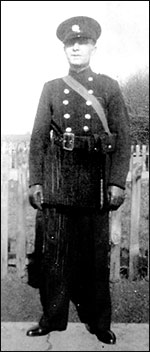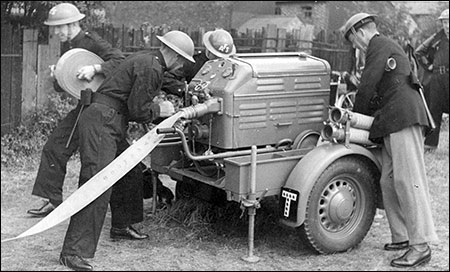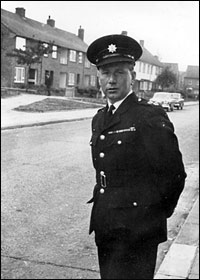During 1938, in keeping with other Local Authorities, Rushden formed a branch of the Auxiliary Fire Service, (AFS). This was formed to provide additional fire fighting capabilities in the event of war being declared in the future.
 |
|
Herbert Chapman
|
My father, Herbert Chapman, joined up as one of the many unpaid volunteers, who were trained to do basic fire fighting, and to use the appropriate equipment.
The volunteers had to complete 60 hours of training before they were considered competent to help the other "Retained firemen" who were the mainstay of the fire brigade at that time under the command of the Fire Officer, Mr. Frank Timpson. Retained firemen were I believe, part time but paid if called out.
The AFS personnel, were, in addition to other duties, trained to use small mobile fire pump units, these were highly effective as they were powered by a very powerful Coventry Climax engine, which was used in small racing cars.
The unit was equipped with fire hoses and suction pipes so that it could use a street hydrant or ponds or later during the war, take water from one of the numerous static water tanks constructed at various locations in the town.
I remember that there were competitions between various groups within the AFS, taking the form of time trials. These were fiercely fought events.
The pump had to be taken to a water supply, connected up, two lengths of hoses run out, the pump started and a target had to be hit by the water jet. The fastest team being the winners.
 |
|
AFS logo on the helmets
|
The gentleman on the left carrying the hose is I believe Mr F Egan, the second from the left is Mr Herbert Chapman.
In August 1941, now under wartime conditions, the AFS was redesignated the National Fire Service, (NFS), which was run by a centralised government body. They set common stands for equipment and training, to enable the volunteers to be moved out of area in the event of major problems, knowing that the equipment and procedures were all compatible.
During the war time my father and his colleagues were required to stay overnight at the fire station on a rota basis. At other times they attended the fire station after the air raid siren had sounded, as this was the only way they could be called out.
Later we had a fire bell fitted in our house which was rung if he was required to attend. This system continued after the war had ceased.
My father remained a part time fireman for some years, giving up some time after the end of the war. However our family connection with the fire service did not end then.
My cousin Mary Swales who lived in Rushden, met a soldier, Sergeant Maurice Hollis, usually known as "Ginge" due to his red hair. He was in the 15/19 Hussars who were temporarily billeted in Rushden, en route to the war in Europe. They were married and he left to go to Europe with his regiment. He served there with distinction and conspicuous bravery for which he was awarded the Military Medal.
 |
|
Station Officer Maurice Hollis
|
The medal citation said that Sgt Hollis was commanding a tank supporting the Coldstream guards, in a battle at the Meuse-Escaut canal in Belgium. They were under heavy fire from the enemy, and the condition was critical. Sgt Hollis commanded his tank with such calm and skill, and knocked out three enemy self propelled guns which saved the situation.
On being demobilised he returned to Rushden to consider his future. Encouraged by my father, he applied for, and was accepted as a full time fireman at the Rushden Station.
At this time, full time firemen were being employed and the part time volunteers were being phased out.
Due to his enthusiasm and dedication he was quickly promoted to Leading Fireman, and 1957 he took over the senior position of Station Officer the appointment that Mr. A Timpson had held for many years.
During 8th December 1958 the brigade was called to a fire at Keunens' tannery, (between Higham and Irthlingborough). There was a man trapped in the building. Station Officer Hollis put on breathing apparatus, and climbed to the first floor to locate the man.
This rescue led to him being awarded The Queens Commendation for Bravery.
Again the citation for this award, praised his bravery, for going into a very hazardous fire and smoke filled building to rescue the man. He dragged him 60 feet, in complete darkness to safety, and he collapsed with exhaustion after the rescue.
Station Officer Hollis subsequently left the Rushden Brigade being promoted to the position of Divisional Fire Officer for Northampton.
He tragically died at the very early age of 62.
From Derek Chapman, via email April 2012
|